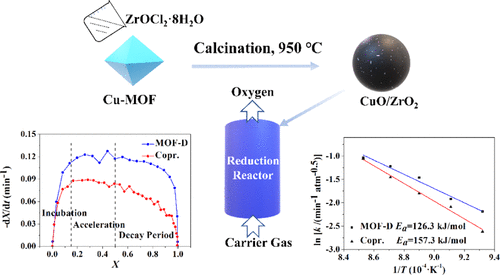当前位置:
X-MOL 学术
›
ACS Sustain. Chem. Eng.
›
论文详情
Our official English website, www.x-mol.net, welcomes your
feedback! (Note: you will need to create a separate account there.)
Efficient Metal–Organic Framework-Derived Cu–Zr Oxygen Carriers with an Enhanced Reduction Reaction Rate for Chemical Looping Air Separation
ACS Sustainable Chemistry & Engineering ( IF 7.1 ) Pub Date : 2020-09-14 , DOI: 10.1021/acssuschemeng.0c04062 Guida Li 1 , Jianling Li 1 , Bo Jin 1 , Wenhao Ji 1 , Yangqiang Huang 1 , Xiao Luo 1 , Zhiwu Liang 1
ACS Sustainable Chemistry & Engineering ( IF 7.1 ) Pub Date : 2020-09-14 , DOI: 10.1021/acssuschemeng.0c04062 Guida Li 1 , Jianling Li 1 , Bo Jin 1 , Wenhao Ji 1 , Yangqiang Huang 1 , Xiao Luo 1 , Zhiwu Liang 1
Affiliation

|
As a key to realize the chemical looping air separation (CLAS) process, CuO is a good oxygen carrier candidate because of its high oxygen transport capacity and excellent thermodynamic characteristics. However, it is hampered by easy deactivation during redox cycles. In this work, a Cu–Zr oxygen carrier is developed via a metal–organic framework (MOF) self-templated method to realize high redox reactivity and favorable thermal stability for the CLAS process. The physicochemistry property and reduction kinetics are investigated through isothermal redox cycles, material characterizations, and reduction kinetic modeling. Compared to the coprecipitated oxygen carrier (Copr.), the MOF-derived oxygen carrier (MOF-D) obtains a 35% faster average reaction rate at the temperature interval of 800–900 °C, especially a 60% reduction rate increase at 850 °C. This enhanced reaction rate is mainly ascribed to the lower intrinsic activation energy (126.3 kJ·mol–1 for MOF-D vs 157.3 kJ·mol–1 for Copr.) rather than the amount of active oxygen species. The oxygen-releasing mechanisms for the MOF-derived and coprecipitated oxygen carriers follow the nucleation and nuclei growth model with a transition of one-dimensional growth to two-dimensional nucleation at two temperature ranges (800–825 and 850–900 °C). This study offers a new route to develop an efficient oxygen carrier for the CLAS process.
中文翻译:

高效金属-有机骨架衍生的Cu-Zr氧载体,具有提高的还原反应速率,用于化学回路空气分离
作为实现化学回路空气分离(CLAS)工艺的关键,CuO具有很高的氧气传输能力和出色的热力学特性,因此是很好的候选氧气载体。但是,它在氧化还原循环中容易失活,因而受到阻碍。在这项工作中,通过金属有机骨架(MOF)自模板化方法开发了Cu-Zr氧载体,以实现CLAS工艺的高氧化还原反应性和良好的热稳定性。通过等温氧化还原循环,材料表征和还原动力学模型研究了理化性质和还原动力学。与共沉淀氧载体(Copr。)相比,源自MOF的氧载体(MOF-D)在800-900°C的温度区间内获得的平均反应速率快35%,尤其是在850℃时还原速率提高了60% ℃。-1用于MOF-d VS 157.3千焦·摩尔-1为COPR。),而不是活性氧种的量。MOF衍生和共沉淀的氧载体的释氧机制遵循成核和核生长模型,在两个温度范围(800-825和850-900°C)下,从一维生长到二维成核。这项研究为开发用于CLAS工艺的高效氧气载体提供了一条新途径。
更新日期:2020-10-05
中文翻译:

高效金属-有机骨架衍生的Cu-Zr氧载体,具有提高的还原反应速率,用于化学回路空气分离
作为实现化学回路空气分离(CLAS)工艺的关键,CuO具有很高的氧气传输能力和出色的热力学特性,因此是很好的候选氧气载体。但是,它在氧化还原循环中容易失活,因而受到阻碍。在这项工作中,通过金属有机骨架(MOF)自模板化方法开发了Cu-Zr氧载体,以实现CLAS工艺的高氧化还原反应性和良好的热稳定性。通过等温氧化还原循环,材料表征和还原动力学模型研究了理化性质和还原动力学。与共沉淀氧载体(Copr。)相比,源自MOF的氧载体(MOF-D)在800-900°C的温度区间内获得的平均反应速率快35%,尤其是在850℃时还原速率提高了60% ℃。-1用于MOF-d VS 157.3千焦·摩尔-1为COPR。),而不是活性氧种的量。MOF衍生和共沉淀的氧载体的释氧机制遵循成核和核生长模型,在两个温度范围(800-825和850-900°C)下,从一维生长到二维成核。这项研究为开发用于CLAS工艺的高效氧气载体提供了一条新途径。











































 京公网安备 11010802027423号
京公网安备 11010802027423号